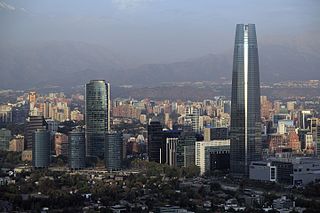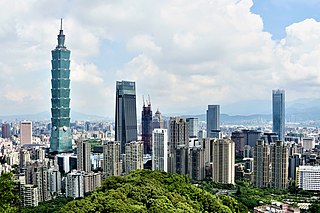
The economy of Canada is a highly developed mixed economy, the world's ninth-largest as of 2024, and a nominal GDP of approximately US$2.117 trillion. Canada is one of the world's largest trading nations, with a highly globalized economy. In 2021, Canadian trade in goods and services reached $2.016 trillion. Canada's exports totalled over $637 billion, while its imported goods were worth over $631 billion, of which approximately $391 billion originated from the United States. In 2018, Canada had a trade deficit in goods of $22 billion and a trade deficit in services of $25 billion. The Toronto Stock Exchange is the tenth-largest stock exchange in the world by market capitalization, listing over 1,500 companies with a combined market capitalization of over US$3 trillion.

The economy of Chile operates as a market economy and is classified as a high-income economy by the World Bank. It is recognized as one of the most prosperous countries in South America, leading the region in areas such as competitiveness, income per capita, globalization, economic freedom, and low levels of perceived corruption. Despite its prosperity, Chile experiences significant economic inequality, as reflected by its Gini index, though this is close to the regional average. Among Organisation for Economic Co-operation and Development (OECD) countries, Chile has a robust social security system, with social welfare expenditures amounting to approximately 19.6% of GDP.

The economy of Indonesia is a mixed economy with dirigiste characteristics, and it is one of the emerging market economies in the world and the largest in Southeast Asia. As an upper-middle income country and member of the G20, Indonesia is classified as a newly industrialized country. Indonesia nominal GDP reached 20.892 quadrillion rupiah in 2023, it is the 16th largest economy in the world by nominal GDP and the 8th largest in terms of GDP (PPP). Indonesia's internet economy reached US$77 billion in 2022, and is expected to cross the US$130 billion mark by 2025. Indonesia depends on the domestic market and government budget spending and its ownership of state-owned enterprises. The administration of prices of a range of basic goods also plays a significant role in Indonesia's market economy. However, micro, medium and small companies contribute around 61.7% of the economy and significant major private owned companies and foreign companies are also present.

The economy of Malaysia is an emerging and developing, upper-middle income, highly industrialised, mixed economy. It ranks the 36th largest in the world in terms of nominal GDP, however, when measured by purchasing power parity, its GDP climbs to the 30th largest. Malaysia is forecasted to have a nominal GDP of nearly half a trillion US$ by the end of 2024. The labour productivity of Malaysian workers is the third highest in ASEAN and significantly higher than Indonesia, Vietnam, and the Philippines.

The economy of Taiwan is a highly developed free-market economy. It is the 8th largest in Asia and 21st-largest in the world by purchasing power parity, allowing Taiwan to be included in the advanced economies group by the International Monetary Fund. Taiwan is notable for its rapid economic development from an agriculture-based society to an industrialized, high-income country. This economic growth has been described as the Taiwan Miracle. It is gauged in the high-income economies group by the World Bank. Taiwan is one of the most technologically advanced computer microchip and high-tech electronics industries makers in the world.

The economy of Vietnam is a developing mixed socialist-oriented market economy. It is the 33rd-largest economy in the world by nominal gross domestic product (GDP) and the 26th-largest economy in the world by purchasing power parity (PPP). It is a lower-middle income country with a low cost of living. Vietnam is a member of the Asia-Pacific Economic Cooperation, the Association of Southeast Asian Nations and the World Trade Organization.
Japan External Trade Organization is an Independent Administrative Institution established by Japan Export Trade Research Organization as a nonprofit corporation in Osaka in February 1952, reorganized under the Ministry of International Trade and Industry (MITI) in 1958, and became an Independent Administrative Institution in 2003 to consolidate Japan's efforts in export promotion. The government has provided more than half of JETRO's annual operating budget. As of January 2020, JETRO maintained seventy-four offices in fifty-four countries, as well as forty-eight regional offices in Japan, with a total staff of 1,730. Its main office is located in the Ark Mori Building in Akasaka, Tokyo. Initially, JETRO's activities focused mainly on promoting exports to other countries. As exporters established themselves in world markets and the balance of trade turned from deficit to surplus, however, JETRO's role shifted to encompass more varied activities. These have included the furtherance of mutual understanding with trading partners, strategic investment attraction, import promotion, liaison between small businesses in Japan and their overseas counterparts, and data dissemination. Import promotion services have included publications, promotion of trade fairs, seminars, and trade missions.

The economy of the European Union is the joint economy of the member states of the European Union (EU). It is the second largest economy in the world in nominal terms, after the United States, and the third largest at purchasing power parity (PPP), after China and the US. The European Union's GDP is estimated to be $19.40 trillion (nominal) in 2024 or $28.04 trillion (PPP), representing around one-sixth of the global economy. In 2023, Germany, France and Italy were the three largest economies in the European Union, accounting for approximately 53.1% of the EU's total GDP. Germany contributed 24.3%, while France accounted for 16.4 and Italy for 12.4%. In the same year, the social welfare expenditure of the European Union (EU) as a whole was 26.8% of its GDP.
In its economic relations, Japan is both a major trading nation and one of the largest international investors in the world. In many respects, international trade is the lifeblood of Japan's economy. Imports and exports totaling the equivalent of nearly US$1.309.2 Trillion in 2017, which meant that Japan was the world's fourth largest trading nation after China, the United States and Germany. Trade was once the primary form of Japan's international economic relationships, but in the 1980s its rapidly rising foreign investments added a new and increasingly important dimension, broadening the horizons of Japanese businesses and giving Japan new world prominence.
Africa has been an important world region for Japan's trade and investment. Japan had some historical experience with Africa and little interest in economic ties with the region, except for development of raw material supplies.

International Enterprise Singapore was a statutory board under the Ministry of Trade and Industry of the Government of Singapore. It facilitated the growth of Singapore-based companies overseas and promoted international trade.

Manufacturing is a vital economic sector in the United States of America. The United States is the world's second-largest manufacturer after the People's Republic of China with a record high real output in 2021 of $2.5 trillion.
Since the end of apartheid, foreign trade in South Africa has increased, following the lifting of several sanctions and boycotts which were imposed as a means of ending apartheid.

Relations between the European Union (EU) and Japan date back to 1959. They have a strong trade relationship, particularly in investment flows.
Foreign trade in India includes all imports and exports to and from India. At the level of the Central Government, trade is administered by the Ministry of Commerce and Industry. Foreign trade accounted for 48.8% of India's GDP in 2018.

Mary Ng December 16, 1968 is a Canadian politician. A member of the Liberal Party of Canada, she has been the Member of Parliament for the riding of Markham—Thornhill since a by-election on April 3, 2017. She has served as Minister of Export Promotion, International Trade and Economic Development since 2023. In addition to this role, Ng has held various portfolios including Minister of International Trade, Export Promotion, Small Business and Economic Development (2021), Minister of Small Business, Export Promotion and International Trade (2019), Minister of Small Business and Export Promotion (2018). As of January 2025, Ng holds the record as Canada's longest-serving minister responsible for international trade at over 5 years in the role.

Metropolitan Chamber of Commerce and Industry, Dhaka (MCCI), established in 1904, is the oldest trade organization of Bangladesh.











